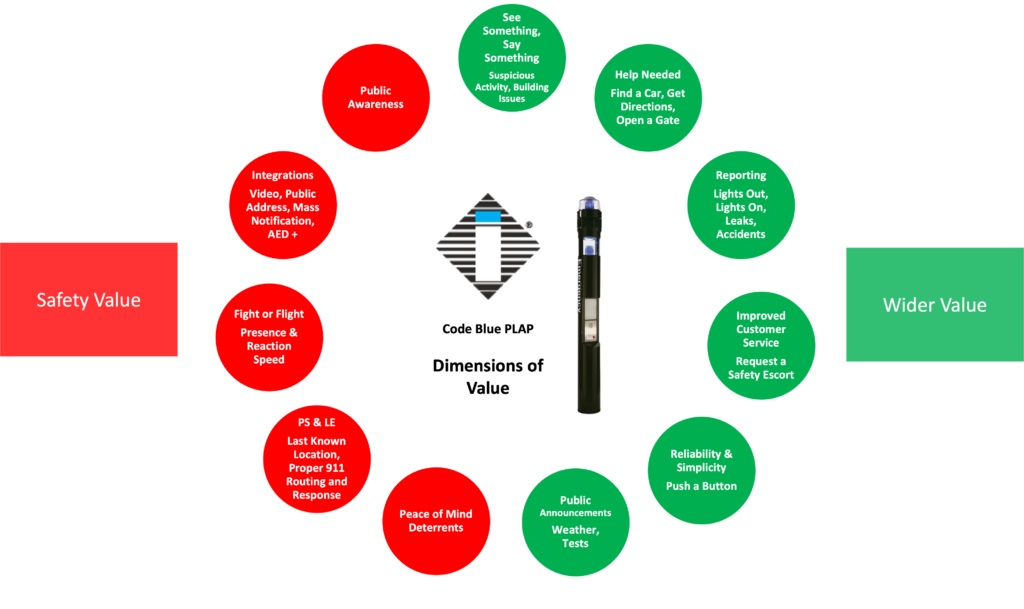CAMPUS-WIDE COMMUNICATIONS SERIES

Download this post in PDF format here:
Background
Code Blue developed this article to help System Integrators and Customers understand perspectives and considerations around the importance of physically located Help Point® communication devices in a campus setting. We will cover key dimensions of this approach, including the apparent and perceived value of physically located Help Points®.
Additionally, we will point out the range of catalysts for human engagement, such as See-Something-Say-Something, help needed, directions, locations, emergencies, and other general requests. Figure 1 depicts a high-level view of the content in this article.
Please remember that Code Blue is always ready to help with any questions regarding our solutions. No one should feel like they are on an island. Together, we are a community dedicated to assisting Public Safety.
Dimensions of Value Associated with Blue Light and Physically Located Access Points (PLAP)

Figure 1
Safety Values and Wider Values of a Help Point®
Wider Communications and Value Dimensions – Blue Light and Physically Located Access Points (PLAP) offer many benefits in common situations outside of emergencies:
- See Something Say Something: Reporting Suspicious Activity: If someone observes suspicious behavior or a potential security threat, but it’s not an immediate emergency, they can use these phones to alert security personnel. This helps in maintaining a safer environment for everyone.
- Assistance with Vehicle Problems: In parking lots or along roadways, these phones can be used to call for assistance with car issues like flat tires, dead batteries, or lockouts.
- Public Announcements: In some cases, blue light phones are integrated into a broader public address system, allowing for announcements or alerts to be broadcast, such as weather warnings or other non-emergency information.
- Checking In: In situations where someone might feel uneasy but not necessarily in imminent danger, they can use these phones to check in with campus or facility security.
- Facility Issues Reporting: They can be used to report facility-related issues like broken lights, slippery floors, or vandalism, contributing to overall maintenance and safety.
- Information and Directions: These phones can be used to ask for information or directions, especially in large campuses or public spaces where someone might get lost or need guidance.
- Safety Escort Services: On university campuses or large facilities, individuals can use blue light phones to request a safety escort during late hours. This service is particularly valuable for those who feel unsafe walking alone at night.
- General Assistance: For general queries or assistance that don’t require immediate emergency response, such as lost and found inquiries or reporting lost assets, these phones can be a valuable resource.
Traditional Public Safety Value Dimensions – Blue Light and Physically Located Access Pionts (PLAP) offer many benefits in common situations like emergencies:
- Better Public Safety Response and Proper 911 Call Routing: Calling for emergency help through a PLAP can improve response and 911 call routing. Such workflows are already set and tested, and user decision-making is limited to just a push of a button. Direct calls to 911, in some cases, can end up going to the wrong authority having jurisdiction.
- Safety in Public Spaces: They are often placed in public spaces like university campuses, parking lots, and parks, enhancing the safety of these areas. Knowing that help is just a push of a button away can make people feel safer, especially in less populated or poorly lit areas.
- Crime Deterrence: The presence of blue light phones can act as a deterrent to potential criminals. The visibility of these phones indicates that emergency services can be quickly alerted, which might discourage criminal activities in their vicinity.
- No Need for a Personal Device: In situations where someone doesn’t have a mobile phone, or if their phone is lost, stolen, or out of battery, blue light phones serve as an essential means of communication.
- Simple to Use: These phones are designed for ease of use, requiring just the push of a button to connect with emergency services. This simplicity is crucial in high-stress situations when operating a phone and dialing numbers might be challenging.
- Locations Tracking: When used, blue light phones can help emergency responders quickly locate the caller. This is particularly important in large campuses or parks where finding someone in distress might otherwise be difficult.
- Public Awareness: Their prominent placement and distinctive appearance raise public awareness about safety and emergency preparedness.
- Inclusivity: Blue light phones are an inclusive safety measure, ensuring that everyone, regardless of whether they own a mobile phone or not, has access to emergency services.
Market and Customer Perspectives
The myth that the presence of blue-light phones exclusively indicates high-crime areas is not true. Rather, they are installed as a precautionary and communications measure to ensure safety and quick access to help and information in various locations and situations. These phones are particularly common in areas where people may be alone or isolated, such as parking garages, remote areas of college campuses, or large parks. They are part of broader communication strategies to improve customer service and safety.
Institutions should ensure that student government representatives are included in major public safety policies. Here are just a few examples of student reactions to post-policy changes that they may not have participated in:
- In an article from The Daily Nebraskan, after a choice was made to remove blue-light phones, Emily Strassburger raised an interesting counterpoint perspective: “When campuses remove the blue phones, they’re shifting too much responsibility on to students. Instead of universities contributing to provide a safe campus, students are forced to make sure they’re able to keep themselves secure. This isn’t to say students shouldn’t have to take personal precautions or that universities are solely responsible for their well-being. But college campuses should be eager to ensure their students are provided a safe environment.”
- In protest through a posted petition aimed at the University of Tulsa, students explained their reasons why blue light phones are very important. “As most people have seen already, the University of Tulsa is planning to remove the blue light phones and have placed a QR code for an app in their place. This is endangering the welfare of our students and staff. Phones are not always readily available; they could die, be off for class, or some people might not even have a phone capable of downloading the app. Not everyone has a smartphone, or a phone at all. In emergencies, we don’t always have a chance to dig out our phones, unlock them, and use an app, which is time-consuming and a waste of valuable time in an emergency.”
Research shows blue light emergency phones help deter crimes, and students and parents still want the technology on campus. There is a myth that they evoke crime or are only used in high-crime areas.
- Rice University in Houston, Texas, once had a stained history of criminal incidents, similar to the city of Houston’s high crime rate. However, after Rice installed 80 blue light emergency phones, the following year, the school reported that the overall crime rate on campus decreased despite the city of Houston’s crime rate remaining high. Specifically, on-campus burglaries plummeted by 67.74%.
- As the number of blue light phones increased, the perception and awareness of the campus’ security also increased, deterring the number of on-campus burglaries from being attempted.
Blue Light Phones Can Help Increase Enrollment.
- Public safety is important for maximizing attendance. A study by the University of Southern California found that public venues with increased security measures have higher attendance rates. This is because visible security equipment increases the venue’s perceived safety, making people feel more comfortable attending the venue.
- According to a 2015 Noodle Survey of 985 parents, the most important factor considered when evaluating potential colleges for their respective children is how safe the campus environment is. For this reason, the University of Purdue is increasing the number of emergency phones on campus.
- “Some institutions are phasing out emergency telephone systems, but we are adding more. The number of boxes used to be around 250, and we have increased them to around 300,” said Song Kang, Captain of Special Services for the Purdue Police Department. “We find that students like them, and parents love them—knowing that there is an added layer of safety.”
- In 2019, hundreds of students at the University of Florida protested after the UF student government failed to pass a resolution for emergency blue light phones to be implemented on Fraternity Drive.
- Christina Pugliese, a sophomore at UF, spoke on the Senate floor in the spring during public comment, demanding support for placing blue lights on Fraternity Drive. “If I had it my way, every single fraternity would have a blue light on it, but we don’t have that,” she said. “We got to take it one step at a time.”
- UF Police Major Blake Barber said UFPD and UF administration support having more blue lights on campus and are looking at proposals to install them on fraternity row. “We want to emphasize that we listen to our community members when they are bringing forward issues of concern and looking at how we can address them,” Barber said.
Blue Light Phones Call Attention
Seamlessly woven into the security landscape, Blue Light phones extend the reach of mobile security apps through their robust emergency communication solutions.
Sean Ahrens, the security market group leader at Affiliated Engineers, stresses the importance of providing communication devices such as Blue Light Phones, even if a mobile application is available. During an orientation tour at a university, the tour guide stated, “The university is moving away from call boxes in favor of iOS and Android mobile applications” and was very excited about it. Sean thought, “As I look down at my phone, I see something interesting. I have no signal”. Sean suggests several important design factors for using Blue Light Phones, including “Call boxes should always have a wayfinding light and a strobe luminary. This is critical to deterring malicious actors. A high-powered strobe will call attention to the area and help first responders find it and the person who called.”
Too many campus communication systems do not provide the exact location of callers, commonly known as a critical component required to provide prompt assistance. This is just one point that relates to ADA. The ADA requires that Title II entities (State and local governments) and Title III entities (businesses and nonprofit organizations that serve the public) communicate effectively with people who have communication disabilities. The goal is to ensure that communication with people with these disabilities is equally effective as communication with people without disabilities.
We hope the Code Blue Team has helped you better understand the importance of physically located Help Point® communication devices in a campus setting. Clearly, there are numerous issues beyond emergencies that must be considered.
Please contact Code Blue (https://codeblue.com/contact) to learn how we can tailor a solution for your Public Safety operations.
